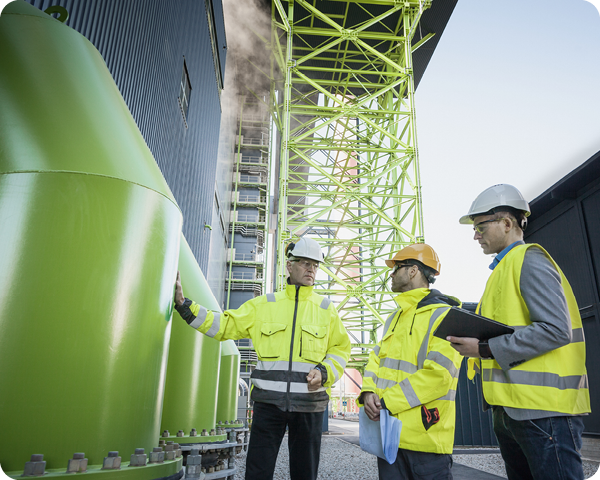When it comes to COP28, people matter: Why social sustainability is top of the agenda
In the first two weeks of September, devastating floods submerged eight regions around the globe – waters surged through eastern Libya, severe rain poured into Greece and Turkey, and parts of Brazil, central Spain, southern China, Hong Kong and regions of the southwestern US were all under water.
It’s no surprise then that, as governments and businesses gathered to discuss climate action at last year's COP28 summit, the social impacts of climate change, and social issues more broadly, were closer to the top of the agenda. Core social themes at the recent summit included health and relief, recovery and peace, gender equality and accountability, the just transition and Indigenous peoples, as well as youth, children, education and skills .
Where for many organizations, their understanding of good environmental practice and governance has for the most part coalesced around reaching net zero carbon, the definition of good practice when it comes to social concerns – the S of ESG – is still evolving. As happened in the early days of environmental reporting, there are now, especially leading on from COP28, discussions taking place about what good practice looks like and how it should be measured and reported.
Some – for example, the UN Global Compact to firms like Deloitte and Robeco – have begun to define it as ‘social sustainability’: “an organization's ability to meet the needs of its stakeholders, including employees, customers, suppliers, and local communities, while also ensuring that social justice, equity, and fundamental rights are upheld.”
In practice, the range of these considerations is broad. Take just one example within the COP28 theme of health and recovery – the effect of flooding on physical and mental health as one of the impacts on populations of climate disasters and changing weather patterns.
The social impacts of flooding obviously include the immediate risk of death from drowning, but organizations such as the European Agency for Health and Safety at Work highlight other hazards: longer term and chronic impacts such as the potential rise in cholera, malaria and other waterborne diseases, as well as the mental health toll of post-traumatic stress disorder, anxiety and depression that come from the effects of weather events on people’s living standards.

To give another example that’s perhaps closer to the workplace: The International Labour Office’s 2019 report Working on a warmer planet: The impact of heat stress on labour productivity and decent work found that by 2030 heat stress is projected to reduce total working hours worldwide by 2.2% and global GDP by US$2,400 billion. The Atlantic Council’s Adrienne Arsht Rockefeller Foundation Resilience Center 2021 report Extreme Heat, The Economic and Social Consequences for the United States found that the US could lose on average approximately $100 billion annually from heat-induced lost labour productivity.
The statistics highlight the need for a clear and shared understanding of what social sustainability for businesses and organizations looks like. But, as with the early days of carbon accounting and net zero reporting, the scale of the task might seem overwhelming. Social sustainability has a breadth that could present, especially to SMEs, too big a focus for organizations to be able to understand, quantify, measure and then report on.
But just as spheres of influence have come to be acknowledged and measured in carbon impact as Scope One, Two and Three, something similar could be practised in social sustainability, by considering the effect of an organization on its stakeholders in ever-widening spheres of influence.
As with carbon impact, organizations could consider the impact of their operations on their people (People Scope 1), those who are connected to an organization through the supply chain or vicinity of operations (People Scope 2), and those impacted indirectly – such as indigenous populations or vulnerable communities (People Scope 3) .
These expanding spheres of influence could then be framed into an organizational strategy, whether you’re an SME, a multinational or a national government. As the effects of rising global temperatures become increasingly evident , and the impact on people becomes increasingly acute, the need for a clear framework for social governance and practice is clearer than ever. The minds of those at COP28 were focused on social sustainability. It’s time organizations take it seriously too.
Get started
Kate Field is Global Head of Human and Social Sustainability at BSI. Named as one of SHP magazine’s Most Influential Individuals in health and safety in 2021, Kate is BSI’s Global Health, Safety and Well-being expert. She has over 20 years of experience across all sectors, and as the author of the BSI’s Prioritizing People Model© helps us understand the impact digitization has on building workplace trust, engagement and well-being.
1https://www.cop28.com/thematic-program#:~:text=These%20are%3A%20Technology%20%26%20Innovation%2C,through%20both%20content%20and%20speakers
2https://unglobalcompact.org/what-is-gc/our-work/social
3https://www2.deloitte.com/nl/nl/pages/sustainability/articles/beyond-environmental-impact-the-case-of-social-in-esg.html
4https://www.robeco.com/en-uk/glossary/sustainable-investing/social-sustainability
5https://www2.deloitte.com/nl/nl/pages/sustainability/articles/beyond-environmental-impact-the-case-of-social-in-esg.html
6https://oshwiki.osha.europa.eu/en/themes/climate-change-impact-occupational-safety-and-health-osh#:~:text=Flooding%20with%20contaminated%20water%2C%20debris,and%20other%20illnesses%2C%20and%20accidents.
7https://www.ilo.org/wcmsp5/groups/public/---dgreports/---dcomm/---publ/documents/publication/wcms_711919.pdf
8https://www.atlanticcouncil.org/in-depth-research-reports/report/extreme-heat-the-economic-and-social-consequences-for-the-united-states/
9For example, employees, contractors, service providers
10For example, the direct community located at the site of an organization.
11Customers or clients could come in scope 1, 2 or 3 depending on the nature of the activity. For instance, in healthcare, patients would be scope 1.
12https://climate.nasa.gov/effects/





